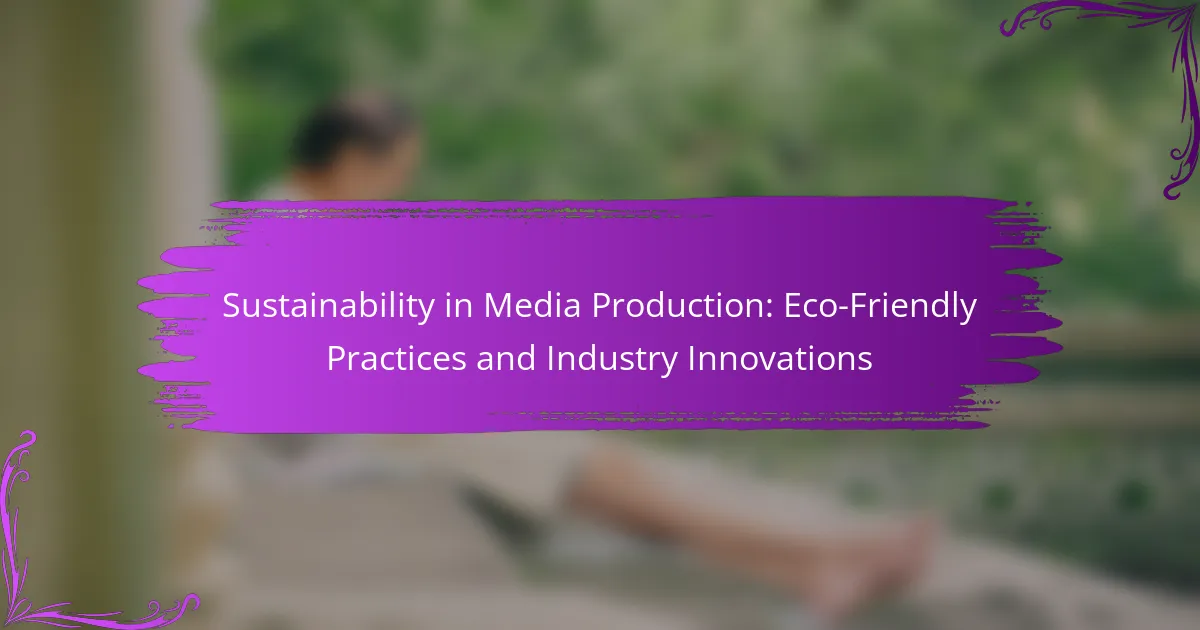
What is Sustainability in Media Production?
Sustainability in media production refers to practices that minimize environmental impact while creating content. This includes using renewable resources, reducing waste, and promoting energy efficiency. Media productions can adopt eco-friendly technologies and methods. For instance, utilizing digital platforms reduces paper usage. Additionally, sustainable sourcing of materials for sets and costumes is vital. The industry increasingly focuses on carbon neutrality. Studies show that sustainable practices can significantly lower production costs. Implementing these strategies supports a healthier planet and promotes social responsibility.
Why is sustainability important in the media industry?
Sustainability is important in the media industry because it reduces environmental impact. The media sector contributes significantly to carbon emissions and waste. Adopting sustainable practices can minimize these effects. For example, using digital platforms reduces paper usage. Additionally, energy-efficient technologies lower electricity consumption. Research indicates that sustainable media practices can attract eco-conscious audiences. According to a study by the Boston Consulting Group, 70% of consumers prefer brands with sustainable practices. This shift can enhance brand reputation and customer loyalty. Implementing sustainability in media production is not just ethical; it is also economically beneficial.
What are the environmental impacts of traditional media production?
Traditional media production has significant environmental impacts. It involves high energy consumption, contributing to greenhouse gas emissions. The printing process requires large amounts of paper, leading to deforestation. Chemical waste from printing inks and processes can pollute water sources. Transportation of media products increases carbon footprints due to fossil fuel use. Additionally, electronic waste from outdated media technologies contributes to landfill issues. According to the Environmental Protection Agency, paper production alone accounts for about 25% of total industrial pollution. These factors highlight the need for sustainable practices in media production.
How does sustainability benefit media production companies?
Sustainability benefits media production companies by reducing operational costs and enhancing brand reputation. Implementing eco-friendly practices often leads to lower energy consumption. For instance, using energy-efficient lighting can reduce electricity bills by up to 30%. Sustainable sourcing of materials minimizes waste, which can cut disposal costs. Companies adopting green practices often attract environmentally conscious clients. This shift can increase market share in a growing eco-aware consumer base. Additionally, sustainability initiatives can improve employee morale and retention. A positive workplace culture fosters creativity and productivity, essential for media production success.
What are the key principles of eco-friendly media production?
The key principles of eco-friendly media production include minimizing waste, reducing energy consumption, and using sustainable materials. These principles aim to lessen the environmental impact of media projects. Minimizing waste involves practices like recycling materials and reducing unnecessary resources. Reducing energy consumption can be achieved through energy-efficient technologies and renewable energy sources. Using sustainable materials means selecting products that are biodegradable or sourced responsibly. Additionally, implementing digital workflows can decrease the need for physical materials. Adhering to these principles can significantly lower the carbon footprint of media production.
What practices are considered eco-friendly in media production?
Eco-friendly practices in media production include using renewable energy sources, reducing waste, and promoting digital over physical materials. Utilizing solar or wind energy for power minimizes carbon footprints. Implementing recycling programs reduces waste generated during production. Choosing digital formats over printed materials decreases resource consumption. Employing energy-efficient equipment lowers electricity usage. Supporting local vendors cuts transportation emissions. Utilizing sustainable materials for sets and props further enhances eco-friendliness. These practices collectively contribute to a more sustainable media production industry.
How can media production companies implement sustainable practices?
Media production companies can implement sustainable practices by adopting eco-friendly technologies and methods. They can utilize energy-efficient equipment to reduce power consumption. Switching to renewable energy sources, such as solar or wind power, can significantly lower carbon footprints. Companies should prioritize digital over physical media to minimize waste. Implementing recycling programs for set materials and props is also essential. Additionally, promoting remote collaboration can reduce travel emissions. Adopting sustainable sourcing for materials ensures that production processes are environmentally friendly. According to a report by the British Film Institute, sustainable practices can reduce production costs while benefiting the environment.

What innovations are driving sustainability in media production?
Innovations driving sustainability in media production include renewable energy use, digital workflows, and sustainable materials. Renewable energy sources, such as solar and wind, are increasingly powering production sets. Digital workflows reduce the need for physical materials, minimizing waste. Virtual production techniques, like LED screens, enhance efficiency and reduce carbon footprints. Eco-friendly materials, such as biodegradable props and recycled costumes, are becoming standard. Advances in remote collaboration tools also decrease travel-related emissions. These innovations collectively contribute to a more sustainable media production industry.
How is technology changing the landscape of sustainable media production?
Technology is transforming sustainable media production by enhancing efficiency and reducing waste. Advanced software tools optimize resource management in production processes. Renewable energy sources are increasingly powering studios and equipment. Virtual production techniques minimize the need for physical sets, cutting material use. Digital distribution reduces the carbon footprint associated with physical media. Data analytics enables better tracking of resource consumption. Innovations in materials lead to eco-friendly alternatives for props and sets. These changes collectively contribute to a more sustainable media industry.
What role do renewable energy sources play in media production?
Renewable energy sources play a crucial role in media production by reducing carbon footprints. They provide sustainable power options for filming and broadcasting. Solar, wind, and hydroelectric energy are commonly utilized. These sources help lower production costs over time. For example, solar panels can power equipment on set. The use of renewable energy aligns with industry goals for sustainability. Productions like “The Lion King” and “Game of Thrones” have implemented green energy practices. This shift contributes to a more eco-friendly media landscape.
How are digital tools enhancing sustainability efforts in media?
Digital tools are enhancing sustainability efforts in media by streamlining production processes and reducing waste. These technologies enable remote collaboration, minimizing travel-related carbon emissions. Data analytics help in optimizing resource usage, such as energy and materials. Cloud-based platforms reduce the need for physical storage and transportation of equipment. Virtual reality and augmented reality can simulate environments, reducing the need for extensive set construction. Digital asset management systems improve the efficiency of content storage and retrieval. The use of digital workflows decreases paper consumption significantly. Overall, these tools contribute to a more sustainable media production ecosystem.
What are some examples of successful sustainable media projects?
Successful sustainable media projects include “The Green Film Festival” and “Planet Earth II.” The Green Film Festival promotes environmental awareness through film. It showcases films that highlight sustainability issues. Planet Earth II uses innovative filming techniques to reduce environmental impact. It raised awareness about biodiversity and conservation. Another example is “The Sustainable Production Forum.” This forum connects industry professionals to share eco-friendly practices. These projects demonstrate the potential for media to promote sustainability effectively.
What lessons can be learned from these sustainable media initiatives?
Sustainable media initiatives teach valuable lessons about resource efficiency and environmental responsibility. They highlight the importance of reducing waste in production processes. For instance, using digital platforms minimizes the need for physical materials. These initiatives also emphasize collaboration among stakeholders for greater impact. Engaging audiences in sustainability efforts fosters community awareness and support. Additionally, they demonstrate that eco-friendly practices can enhance brand reputation. Companies that adopt sustainable methods often see increased consumer loyalty. Overall, these lessons encourage a shift towards greener practices in the media industry.
How do these projects measure their environmental impact?
These projects measure their environmental impact through various methodologies. They often utilize carbon footprint assessments to quantify greenhouse gas emissions. Life cycle assessments are also employed to evaluate the environmental effects of production from start to finish. Additionally, projects may implement sustainability reporting frameworks, such as the Global Reporting Initiative. These frameworks provide standardized metrics for tracking environmental performance. Surveys and stakeholder feedback can further gauge the impact of eco-friendly practices. Some projects use software tools to analyze resource consumption and waste generation. Furthermore, industry benchmarks help compare performance against established sustainability goals.

How can media professionals contribute to sustainability?
Media professionals can contribute to sustainability by implementing eco-friendly practices in their work. They can reduce energy consumption by using energy-efficient equipment and optimizing production schedules. Utilizing digital platforms minimizes paper waste and promotes virtual collaboration. Media professionals can also prioritize sustainable sourcing of materials and props for productions. Additionally, they can advocate for environmental issues through their content. Highlighting sustainability initiatives raises awareness among audiences. Collaborating with organizations focused on environmental conservation amplifies their impact. Research shows that sustainable media practices can significantly lower carbon footprints in production settings.
What skills are essential for promoting sustainability in media production?
Essential skills for promoting sustainability in media production include project management, environmental awareness, and effective communication. Project management skills help coordinate sustainable practices throughout production. Environmental awareness enables professionals to understand the ecological impact of their choices. Effective communication fosters collaboration among team members to implement sustainable strategies. Knowledge of green technologies is also crucial. Familiarity with energy-efficient equipment reduces carbon footprints. Additionally, understanding regulations related to sustainability ensures compliance. Creative problem-solving allows teams to innovate eco-friendly solutions. These skills collectively enhance the media production process while minimizing environmental harm.
How can collaboration enhance sustainability efforts in the media industry?
Collaboration can enhance sustainability efforts in the media industry by pooling resources and expertise. When media organizations work together, they can share best practices for reducing waste. This includes adopting eco-friendly technologies and sustainable materials. Collaborative projects can lead to innovative solutions that individual companies might not achieve alone. For instance, joint initiatives can promote energy-efficient production methods. Research shows that collaborative networks can reduce carbon footprints by up to 30%. Furthermore, partnerships can amplify the impact of sustainability campaigns, reaching wider audiences. This collective approach fosters a culture of sustainability within the industry. Ultimately, collaboration drives measurable improvements in environmental performance.
What role does education play in fostering sustainable practices?
Education plays a crucial role in fostering sustainable practices. It raises awareness about environmental issues and promotes understanding of sustainability principles. Educational programs teach individuals the importance of reducing waste and conserving resources. Schools and universities integrate sustainability into their curricula, preparing future leaders to prioritize eco-friendly practices. Research indicates that educated individuals are more likely to adopt sustainable behaviors. For instance, a study published by the Journal of Environmental Education found that students exposed to sustainability education demonstrate increased recycling rates and energy conservation efforts. Education empowers communities to implement sustainable solutions effectively.
What are the best practices for individuals and companies in media production?
Best practices for individuals and companies in media production include adopting eco-friendly practices, utilizing sustainable resources, and minimizing waste. Implementing energy-efficient technologies reduces carbon footprints. Choosing digital formats over physical media decreases resource consumption. Collaborating with local vendors supports the community and reduces transportation emissions. Educating teams on sustainability promotes a culture of environmental responsibility. Tracking and measuring the environmental impact of productions helps identify areas for improvement. Research shows that companies implementing these practices can enhance brand reputation and attract eco-conscious audiences.
How can media professionals adopt sustainable habits in their work?
Media professionals can adopt sustainable habits by implementing eco-friendly practices in their workflows. They can reduce paper usage by going digital for scripts and notes. Utilizing energy-efficient equipment lowers power consumption during production. Choosing sustainable materials for sets and props minimizes environmental impact. Media professionals should also prioritize local sourcing to reduce transportation emissions. Incorporating recycling programs into their operations promotes waste reduction. Collaborating with organizations focused on sustainability can enhance their knowledge and practices. Regular training on sustainability can keep teams informed about best practices. These actions collectively contribute to a more sustainable media industry.
What resources are available for learning about sustainable media production?
Resources for learning about sustainable media production include online courses, books, and industry organizations. Websites like Coursera and Udemy offer courses focused on eco-friendly practices in media. Books such as “Sustainable Filmmaking” by A.J. Dyer provide in-depth knowledge on the subject. The International Alliance for Sustainable Media Production offers resources and networking opportunities. Additionally, industry conferences often feature workshops on sustainability. These resources collectively enhance knowledge and skills in sustainable media production.
Sustainability in media production encompasses practices aimed at minimizing environmental impact while creating content, including the use of renewable resources, waste reduction, and energy efficiency. The article highlights the importance of adopting sustainable practices within the media industry to reduce carbon emissions and enhance brand reputation, while also discussing the environmental impacts of traditional media production. Key principles of eco-friendly media production are outlined, alongside examples of successful sustainable projects and the role of technology in driving these initiatives. Additionally, the article emphasizes the significance of collaboration, education, and best practices for media professionals to foster sustainability in their workflows.



